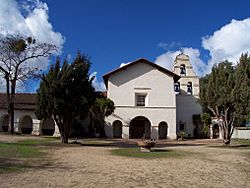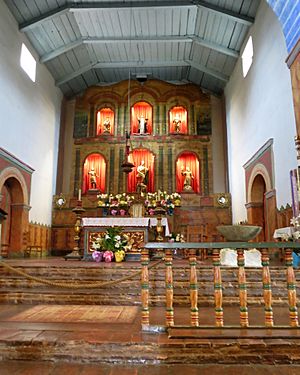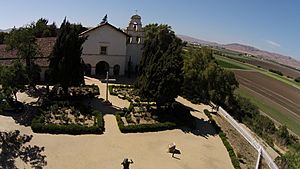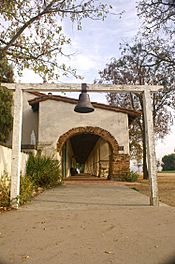Mission San Juan Bautista facts for kids

A view of the Mission San Juan Bautista and its three-bell campanario ("bell wall"). Two of the bells were salvaged by Father Nick Senf in 2009 from the original chime, which was destroyed in the 1906 San Francisco earthquake.
|
|
| Location | 406 2nd Street San Juan Bautista, California 95045 |
|---|---|
| Coordinates | 36°50′42″N 121°32′09″W / 36.845083°N 121.535889°W |
| Name as founded | La Misión del Glorios Precursor de Jesu Cristo, Nuestro Señor San Juan Bautista |
| English translation | The Mission of the Glorious Precursor of Jesus Christ, Our Lord, Saint John the Baptist |
| Patron | Saint John the Baptist |
| Nickname(s) | "Mission of Music" |
| Founding date | June 24, 1797 |
| Founding priest(s) | Father Fermín Lasuén |
| Founding Order | Fifteenth |
| Military district | Third |
| Native tribe(s) Spanish name(s) |
Mutsun, Yokuts Costeño |
| Native place name(s) | Popeloutchom |
| Baptisms | 4,106 |
| Marriages | 1,003 |
| Burials | 2,854 |
| Secularized | 1835 |
| Returned to the Church | 1859 |
| Governing body | Diocese of Monterey |
| Current use | Parish Church |
| Reference no. |
|
| Website | |
| http://www.oldmissionsjb.org/ | |
Mission San Juan Bautista is a historic Spanish mission located in San Juan Bautista, California. It was started on June 24, 1797. Father Fermín de Lasuén of the Franciscan religious group founded it. This mission was the fifteenth one built by the Spanish in what is now California.
The mission is named after Saint John the Baptist. The city of San Juan Bautista also gets its name from the mission. Many buildings were built around a large grassy plaza. These included homes for soldiers, a place for nuns, and the Plaza Hotel. You can still see these buildings today.
Native American people, like the Ohlone and Yokuts, came to live at the mission. They were baptized there. Mission San Juan Bautista has held church services every day since 1797. Today, it still serves as a local church for the Diocese of Monterey.
Contents
Mission History and Growth
After it was founded in 1797, Mission San Juan Bautista quickly grew. By 1803, over 1,000 Native Americans lived there. The mission also became very active in farming and ranching. They had many animals, including cattle, sheep, horses, and mules. Farmers also harvested large amounts of wheat, barley, and corn. Each fanega of grain weighed about 220 pounds.
The "Mission of Music"
In 1815, Father Pedro Estévan Tápis came to the mission. He was very good at music. Father Tápis taught the Native Americans how to sing. He used a special system of music notes from Spain. This system used different colors or textures for different singing parts.
His choir of Native American boys became famous. They performed for many visitors. Because of this, Mission San Juan Bautista earned the nickname "the Mission of Music." Two of Father Tápis's handwritten choir books are still kept at the San Juan Bautista Museum. Father Tápis passed away in 1825 and was buried at the mission. The town around the mission grew quickly during the California Gold Rush. It is still a busy community today.
Earthquakes and Restoration
The mission is located near the San Andreas Fault. This is a major crack in the Earth's crust. Because of this, the mission has been damaged by many earthquakes. Big earthquakes happened in 1800 and 1906. However, the mission was never completely destroyed at one time.
It was first repaired in 1884. Then, a major restoration happened in 1949. This work was paid for by the Hearst Foundation. The campanario, which is a wall with three bells, was fully fixed in 2010. This bell wall is right by the church entrance. A part of the old El Camino Real road is still unpaved near the mission. It sits on a fault line.
Modern Use and Film Appearances
In 1835, the mission was taken over by the government. This process is called secularization. But in 1859, the Catholic Church took it back. It has been a parish church for the Diocese of Monterey ever since. The mission also has a cemetery. Over 4,000 Native Americans and Europeans are buried there.
The mission and its grounds were shown in the 1958 movie Vertigo. This famous film was directed by Alfred Hitchcock. A tall steeple had been added to the mission after it was first built. This steeple was later removed after a fire. For the movie, Hitchcock added a bell tower using models and special camera tricks. This movie tower looked different from the original steeple.
See also
- Spanish missions in California
- List of Spanish missions in California
- Rancho San Justo
- Teatro Campesino






